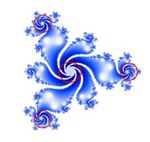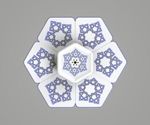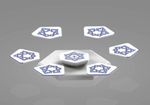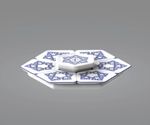Design Practice of Ceramic Tea Set Based on Aesthetic Features of Fractal Pattern
←
→
Page content transcription
If your browser does not render page correctly, please read the page content below
E3S Web of Conferences 179, 02107 (2020) https://doi.org/10.1051/e3sconf/202017902107
EWRE 2020
Design Practice of Ceramic Tea Set Based on Aesthetic Features
of Fractal Pattern
Wenming Liu*, Penghui Chen
School of Design and Art, Shenyang Jianzhu University, Shenyang, Liaoning, 110168, China
Abstract. The unique aesthetic characteristics of the fractal pattern are analyzed and discussed, and the
aesthetic features of the fractal pattern are used to practice the appearance design and decorative pattern
design of the ceramic tea set. Through the practice of product design based on fractal ideas, a set of effective
and feasible ideas and methods for applying fractal ideas to product design were explored, which broadened
product design ideas and tried new possibilities for product design.
and application, people still cannot include such a rich
1 Fractal-related concepts and their fractal world with a concise and general definition.
aesthetic characteristics
Fractal geometry is known as "the geometry of nature", 1.2. Features of fractal patterns
and mathematicians use it as a geometric tool to describe The most significant feature of a fractal pattern is that it
the formation of natural forms. Any complex natural has a form of self-similarity. It can be regarded as a
form can be simulated by treating generators as "genes" symmetry that crosses different scales, and contains the
inherent in complex natural structures, and the final state recursion of the pattern. The self-similarity may be both
can be determined by controlling the number of iterations approximate self-similarity and statistically. For the
through parameters. Therefore, we can see that fractal meaning of "self-similarity", a figure itself can be
geometry can reveal the original appearance and inner regarded as composed of many similar and different parts.
structure of nature more realistically. If euclidean For example, Polish mathematician Wactaw Franciszek
geometry studies the geometry of regular graphics, then Sierpinski (1882-1969) proposed a Sierpinski triangle
fractal geometry studies the geometry of "irregular" named after himself. The Sierpinski triangle is a classic
graphics. case of fractal. It has infinitely fine structure levels and
strict self-similar characteristics. It is very helpful for
1.1. Definition of fractal people to understand the fractal idea vividly, and the
drawing method is very simple and interesting.
The founder of fractal theory, American mathematician Briefly explain the process of drawing the Sierpinski
B. Mandelbrot, gave a definition of "fractal" in 1982: "A triangle: First, let S0 be an equilateral triangle with a side
fractal is by definition a set for which the Hausdorff- length of 1, first step (n=1), connect the midpoints of the
Besicoritch dimension strictly exceeds the topological three sides to get four congruent small triangles, remove
dimension". the middle one Small triangle, keep the remaining three
In 1986, Mandelbrot gave another definition of small triangles to get S1. In the second step (n=2), repeat
fractal "A fractal is a shape made of parts similar to the the previous step for the remaining three small triangles
whole in some way", that is, the fractal has some shape in S1 to obtain S2, which contains nine small triangles. By
features that are partially similar to the whole in some repeating the above steps in this way, Sn can be obtained.
way [2]. This definition only emphasizes some self- When n approaches infinity, a Sierpinski triangle is
similarity of the fractal set, but it is still not obtained. Fig 1 shows the formation process of the
comprehensive. In this way, after a long test of theory Sierpinski triangle.
*Corresponding author’s e-mail: 83373734@qq.com
© The Authors, published by EDP Sciences. This is an open access article distributed under the terms of the Creative Commons Attribution
License 4.0 (http://creativecommons.org/licenses/by/4.0/).E3S Web of Conferences 179, 02107 (2020) https://doi.org/10.1051/e3sconf/202017902107
EWRE 2020
Fig 1. The formation of the Sierpinski triangle.
Because of the self-similarity of fractals, fractal fractal pattern allow it to have non-unique center points.
patterns are infinite in both depth and breadth. At the Multiple center points are scattered uniformly in order
same time, fractal art patterns are created with the help of and restrict each other, thereby avoiding visual conflicts
computers, so that they can surpass the human brain to a and showing a dynamic and balanced vision.
certain extent. Thinking, therefore, the degree of
randomness and arbitrariness of its pattern is relatively
1.3.2. Harmonious. The fractal art pattern has a
large, but this will often produce unexpected effects (new,
mathematically harmonious expression, but this
chic, and strange), showing people a refreshing feeling
harmonious expression has got rid of the indifference and
and a strong sense of the times. Fractals are ubiquitous in
monotony of traditional European geometry, so that the
nature and can be artificially produced. Typical fractals
fractal pattern can be based on the identity and
in daily life include ferns, galaxies, broccoli, and the
supplemented by the fusion of differences. In this way,
blood vessels of the coastline and even the human brain.
each local shape change and each color's situation echo
each other. The transition is natural and there is no
1.3. Aesthetic characteristics of fractal art bluntness. The organic change and unity of this form is
patterns harmony. As shown in Fig 3, the local pattern of the first
level of the fractal pattern serves as a local feature of the
The colorful fractal art pattern has an undisputed visual second level, so that the overall situation has an
shock. With science or aesthetics, people have new excessive relationship that is not intended to be natural,
feelings when they first see the fractal art pattern. and enhances the overall sense of harmony.
Although the fractal art pattern is a computer graphic
generated by the idea of chaotic fractal using a computer
programming language, it shows a new artistic form 1.3.3. Symmetry. Symmetric structure is one of the
different from the traditional form beauty. Its aesthetic typical characteristics of fractal. It is a new form of
characteristics are as follows: symmetry that is different from up and down and left and
right. This symmetry does not bring a monotonous and
rigid feeling like the symmetry of traditional european-
1.3.1. Balance. The balance in the fractal art pattern is a style geometric forms, but the entire fractal pattern can
kind of dynamic balance, but it is different from the contain dynamic beauty in the balance, making people
symmetry in the traditional sense. It is a balance where excited and excited. It can also show rigorous
the whole and the part are mutually restrained, and the correspondence and restrictions, so that this wild
overall visual state is relatively felt. It is this balanced freedom will not lose control and tend to be chaotic[3].
form that makes the fractal pattern more conducive to As shown in Fig 4, the fractal pattern, while inheriting
showing the overall effect of stability, liveliness, the symmetry of the traditional form, also broke through
dexterity and order. The complexity of the fractal pattern its existing expression. It can be said that it is a local and
and the infinitely fine structure are its typical larger part symmetry. Any small-scale part maintains the
characteristics. Although it is complex, it has a balanced shape with the whole Similar, to achieve a harmonious
visual relationship, and the beauty is self-evident. As and balanced visual experience.
shown in Fig 2, the self-similar characteristics of the
Fig 2. Balance in fractal. Fig 3. The fractal in harmony. Fig 4. The fractal in symmetrical.
2E3S Web of Conferences 179, 02107 (2020) https://doi.org/10.1051/e3sconf/202017902107
EWRE 2020
and can achieve refreshing visual effects. The fractal tree
1.3.4. Self-similarity. This self-similarity of fractals and Lévy curve shown in Fig 5 are typical fractal
makes fractal patterns infinite in both depth and breadth. structures. If the part is infinitely enlarged, a small fractal
At the same time, fractal art patterns are created with the tree similar to the whole and a reduced version of the
help of computers, so that it can surpass the thinking and Levi curve can be observed.
imagination of the human brain to a certain extent. , So
its pattern has great randomness and arbitrariness, but
often it is unexpectedly novel, chic, peculiar, and varied,
Fig 5. The fractal’s self-similarity. Fig 6. Julia set.
such as balance, symmetry, harmony and unity. The
1.3.5. Order in chaos. The impression of fractal art computer-generated fractal art pattern is magical,
patterns is often complex and mysterious. However, the beautiful, and unpredictable. It has self-similarity and
aesthetic ideal pursued by fractal patterns is neither infinite fineness. The structure contains new aesthetic
simple nor complicated, but an order in chaos, seeking expressions beyond traditional aesthetics.
richness in unity. As Gombrich said, "Aesthetic pleasure The fractal pattern shown in Fig 7 is a Z6 symmetric
comes from watching a pattern between tedious and fractal generated by a non-linear iterative function
messy; monotonous patterns are difficult to attract system constructed with six parameters with a
people's attention, and overly complex patterns will symmetrical distribution selected in the 1-period
burden our perception system. Too heavy to stop viewing attraction parameter area of a symmetric generalized M
it [4]. "The structure of the fractal pattern is complicated, set of complex polynomials by computer technology 7
it always has an endless winding inside, as shown in the pttern [5]. The pattern has the following characteristics:
Julia set shown in Fig 6, the pattern has an infinitely fine the pattern is six-element rotationally symmetric; if the
structure, each part There are more changes in the edge six vertices are connected, a regular hexagon can be
details. However, the entire pattern is not messy. The formed; it has an infinitely fine structure level; the part
change of clustering and scattering, sparseness and and the whole, the part and smaller parts have symmetry
denseness is particularly appropriate. It contains an and self-similarity ; The pattern starts from the center
internal order, symmetry with the whole. point of the overall figure, and the parts of each level
remain similar to the overall shape. And it is a dynamic
2 Selection and analysis of fractal symmetry, which is a typical feature of a fractal pattern.
This symmetry is different from the traditional symmetry.
patterns in ceramic design practice It is the symmetry between the local and the whole of the
Decorative pattern is an important artistic expression of figure. This dynamic symmetry gives a harmonious
ceramic design, which emphasizes aesthetic principles beauty.
Fig 7. Z6 symmetrical fractal Fig 8. Fractal teaboard.
pattern.
Inspired by the fractal pattern shown in Fig 7, a
3 Conception and details of design hexagonal fractal tea tray was designed, as shown in Fig
practice 8. According to the shape and structural characteristics
shown in Fig 7, a regular hexagon is selected as the
overall outline of the tea tray, and six deformed small
3.1 Design concept
3E3S Web of Conferences 179, 02107 (2020) https://doi.org/10.1051/e3sconf/202017902107
EWRE 2020
hexagon structures with self-similar structural two regular hexagons are arranged at a 30-degree angle
characteristics are used as the dividing nodes of the six to each other. The tea tray boss is in the shape of an
trays according to the first level of the pattern; It was inverted six-sided platform, seen from the front as a pure
artistically and functionally increased and decreased, and lotus, as shown in Fig 10. The top of the tray of the tea
the arrangement and layout were adjusted, mainly to tray can be used for placing the teapot. The fractal
express its meaning rather than copy its shape, so that the pattern shown in Fig. 7 is scaled according to an
fractal pattern is in harmony with the shape of the tea appropriate proportion. The six corners of the pattern
tray. Show aesthetic characteristics such as rhythm and correspond to the six apex directions of the hexagonal
self-similarity. boss and match the top surface of the boss. According to
the structural characteristics of the fractal pattern, 7
circular drainage holes are arranged at the center of the
3.2 Plan details
top surface of the boss of the tea tray, arranged in a
The fractal pattern shown in Fig 7 is a six-unit rotational regular hexagon, corresponding to the directions of the
symmetry. From the perspective of the figure, it rotates six vertices of the boss, and in a small level similar to the
outwards around the center point, and a deformed overall structure There is also a circular drainage hole at
secondary pattern similar to the overall structure appears the center of the pattern, which is used to discharge
in each of the six apex directions. In this design, the waste water. At the same time, the top surface of the boss
center of the fractal pattern is used as the center of the tea is concave, so that the situation of tea overflowing can be
tray, and the six vertices of the pattern are connected by avoided. The inside of the tray base is hollow, as a
straight lines to form a regular hexagon as the outer storage space for waste water. Seven circular drainage
contour of the base of the tea tray. As shown in Fig 9, the holes are arranged in a corner of the tray base, arranged
middle of the tea tray base is a regular hexagonal boss, in a regular hexagon, and can be dumped at any time to
the shape matches the overall structure of the fractal drain the water in the tray base, as shown in the Fig11 is
pattern. The center of the tea tray boss coincides with the shown.
center of the base, and the corresponding positions of the
Fig 9. The vertical view of the fractal Fig 10. The front view of the fractal
teaboard base. teaboard.
Fig 11. The left view of the fractal Fig 12. The vertical view of the fractal
teaboard. tea tray.
The tea tray base is composed of six pentagonal trays. divided into six partial patterns of the same size and
The shape characteristics are derived from the shape and similar to the overall pattern shape, and sequentially
structural characteristics of the fractal pattern, and its connecting the six vertices of the partial pattern to obtain
arrangement and layout are adjusted at the same time. a small hexagonal pattern. Considering that the fractal
According to the characteristics of the fractal pattern pattern and the shape of the tea tray can be properly
shown in Fig 7, the first six levels of the deformed small matched, the shape of the tray is first designed as a
hexagonal structure with self-similar structural hexagon, the six trays form a complete, similarly shaped
characteristics are used as the division nodes of the six large hexagon. Because the tea tray is a convex table
trays; without destroying the overall fractal pattern, shaped like an inverted hexagon, the design needs to use
4E3S Web of Conferences 179, 02107 (2020) https://doi.org/10.1051/e3sconf/202017902107
EWRE 2020
the principle of subtraction and cut out the area occupied complete tea is formed. Fig 13 is a top view of the tea
by the boss, that is, the shape of the final tray is designed tray design. The two outer contour edges of the six trays
as a pentagon. Fig 12 shows a top view of the tray. The are dotted with blue lines. The 12 blue lines are
six self-similar patterns of the first level of the fractal connected to each other, highlighting the overall
pattern are scaled according to the appropriate modeling vitality of the tea tray. From a distance, the tea
proportions, centered on the top surface of the tray, make tray is in full bloom in the pond. A lotus plant is fresh
sure the direction of the pattern apex is the same as the and elegant, bringing a natural and peaceful atmosphere
direction of the top corner of the tray. The six trays are to people.
arranged in sequence, and together with the tray base, a
Fig 13. The vertical view teaboard. Fig 14. The explosion figure of the teaboard.
Fig 14 is an exploded view of a tea tray, which is also simple and clear. The outer surface of the tea cup is
a schematic diagram of tray placement. Six trays are designed as a partial pattern of 1/6 of the fractal pattern.
arranged corresponding to the tray base and the tray boss The pattern is rotated and scaled to a certain angle to
to form a complete hexagonal fractal ceramic tea tray form a connection and echo relationship with the tea cup
structure. The tray is used for the placement of tea cups tray pattern. At the same time, it breaks the original
and Supporting can avoid scalding your fingers due to indifferent geometry and adds some life taste. The teapot
water and heat. At the same time, in order to facilitate its is placed on the upper surface of the middle boss of the
access, the bottom of the outer top corner of the tray is tea plate, and the corresponding positions on the outer
designed to be slanted to provide a position for force to surface of the outer plate are designed with a fractal
lift the tray, as shown in Fig 15. The pattern on the pattern consistent with the tray, which produces a good
surface of the tray also guides the placement of tea cups. sense of stability. As shown in Fig 16, this combination
Tea cups and teapots are produced as a complete set of teapot and cup natural, harmonious, connected and
of tea sets, which are finely crafted, uniform in shape, unified.
Fig 15. The upward view of the fractal Fig 16. The picture of the fractal tea set.
tea tray.
The hexagonal fractal ceramic tea set is suitable for
being placed in the living room, dining room, study,
3.3 Design evaluation
courtyard, office. It can be used for tea drinking and tea
The fascinating appeal of fractal originates from its tasting, as well as ornamental function. The main body
infinite level of local and overall self-similar structural and parts of the tea set reflect the fractal idea, and the
features. It is this self-similar structure of fractal that shape and decoration complement each other, which not
enables users to see a pleasing whole and details from only meets the functional needs of people, but also meets
any distance. The product design practice process the aesthetic needs of people.
involves the organic and overall connection between the
whole and the part, the shape of the tray structure and the 4 Conclusion
appearance of the shape, using the fractal idea as a new
shape design language to guide the design of the product Fractal geometry reveals a kind of "real" geometry that is
shape, forming a new product design idea, reflecting a closer to the original appearance of nature and can better
new aesthetic taste that is different from the traditional show the inner structure of nature. It is called "natural
geometric dullness. geometry" [6]. Applying it to product design can give the
5E3S Web of Conferences 179, 02107 (2020) https://doi.org/10.1051/e3sconf/202017902107
EWRE 2020
product its natural essence, showing an evolutionary and
morphological characteristic of the dynamic growth of
nature.
Use fractal ideas to guide product design and creation,
and apply fractal patterns to the design and research of
ceramic tea sets, which can better express the form
beauty and decorative design elements of ceramic tea,
thereby designing a more humane and able to bring
people ceramic ware that has a stronger visual beauty.
Fractal ideas can provide new inspiration for product
design, expand product design ideas, and inspire more
possibilities. Through the use of fractal ideas and fractal
patterns, the design can reflect infinitely local and overall
self-similar structural characteristics, providing a new
modeling language for product design. The effective
application of fractal ideas in the field of design has also
promoted the development of the concept of fractal,
broadened the application field of fractal disciplines, and
has practical significance and practical application value.
The two promote each other and develop together.
References
1. Mandelbrot, B.B. (1986) The fractal geometry of
nature. W. H. Freeman and Co., San Francisco.
2. Mandelbrot, B.B.(1987) Fractal. Encyclopedia of
Physical Science and Technology.
3. Zhu.W.Y. (2003) Research and Application of
Complex Map M-J Fractal Spectrum Scale
Invariance and Fractal Dimensional Information
Symmetry, Northeast University,Shenyang.
4. Xia.L.L. (2011) Research on the application of
digital graphics in fashion design based on fractal
geometry theory. Zhejiang sci-tech
university,Hangzhou.
5. Feng.D.D. (2016) Research on nonlinear IFS
iterative gunction system constructed from complex
analytic map. Shenyang Jianzhu
University,Shenyang.
6. Zhao.Y.P. (2003) Application of fractal geometry in
architecture. Dalian University of
Technology,Dalian.
6You can also read



























































